Care and Maintenance- Getting the Most from Your JPW Boat
See also the Warranty Verification sheet that you can send in to verify your warranty with us. It also has the National Paddle Sports Safety Warning Label attached.
This story plays over and over for us at JPW, so I thought it would be a good idea to tell it, and put it on a web site. It is mostly fiction, but it is told from the point of view from both someone new to the sport, someone who has been doing this for over 40 years, and the boat..
It is true that inflatable boats need to be strong to withstand the punishment of whitewater, but few boaters new to the sport realize that their boats are the more likely to get damaged in transport than they are on the river. After a few years of boating, a couple of times loaning your boat out to friends, and you will come to understand this. The vast majority of my repairs have been at the put in, usually after a loan to a friend or potential customer. How can this be? Aren’t inflatable boats supposed to be tuff? Isn’t that why we buy them? The answer is yes, when they are inflated and in the water, they are extremely tuff, and they are often built to take punishment from things like rebar in the river. They cannot take the continued abrasion that comes from dragging down a concrete or even wooden ramp, or being rolled up and placed next to objects in a truck and bounced 20 or more miles up a dirt road. One must also consider how a boat needs to be taken care of in the river; the relative safety of being in an eddy with other boats crashing into them, or rubbing up against rocks. On the first morning’s camp of my first Grand Canyon boatman’s job, I had an 18 ft. raft teetering 30 feet in the air on top of a rock. Some lessons are hard learned, and learned early. So this document is a study of what a relative new comer to the sport should expect from an inflatable, and where your attention should be when it comes to keeping your boat in top shape. Remember that most of the difference between new comers and old timers is their view and awareness of how things work, wisdom, and where they received this information. Everyone was a newcomer at one point. We hope, after reading this, that your awareness will shift, and you will be able to avoid a lot of the cost of education the hard way.
A Scenario Your Brand New Boat on its First Trip
It is your first river trip in your brand new boat. You are standing around watching other expedition members rig their boats, and you feel sort of helpless, but you watch and learn. People at the put in are eager to help. You get the job done. Then you get on the river, and the camping is wonderful, and so is the whitewater. Your boat takes a couple of wall shots. Your experienced team mate tells you to let the rubber take the hit. Do not push off of a wall, you could get hurt. Watch your downstream oar! Then you run over some big rocks, some look like they could do some damage. Your boat seems to take it in stride. You start to feel that this boat can handle anything that you throw at it. You are happy that you spent the money to buy a good craft.
Now you are at the take out, and in a hurry to get de rigged. You pull the straps off as fast as you can. You have forgotten the boat bags; they are at the put in. Oh well a boat this tuff can certainly take the ride home. The last thing undone is the first thing in the trailer. That is why the tubes are rolled up and thrown on the bottom. Coolers and frames are piled on top. And up the dusty dry dirt road you go bouncing for 20 or so miles until you hit pavement. Then shift into high gear and home you go.
The next time you take out your boat, it has holes in it. Where did they come from? This was such a good boat on the first trip. It must be the fabric, or the workmanship. I just paid a lot of money for this and it is crap! What happened? The answer of course is that you are not paying attention to the situations that really damage inflatable boats. If you are new to the sport, it is easy to get confused. After all, whitewater is so exciting and at least a bit dangerous. The boat seemed so tuff in the river.
Where the adrenaline comes from
In my boating career, I have been most excited by 2 general things; negotiating major rapids, and when shuttles and drive arounds go bad. I have never had to patch a boat after any of my party was involved in a flip. We have been seriously stuck on rocks, and still no patches. In a flip, we swim out, and if a proper safety net was maintained, it was very exciting, and a big learning experience. Hopefully we were rigged for it, and we still have all our food and gear. What about the drive around? How about the times the trailer came off, or the time we put a bias belted tire on with radials after a flat? How did I ever keep the truck on the road? In a long career, the stories about rolled vehicles mount up. Our customers are more than happy to tell us how they lived through those experiences. What happens when you forget to tie down your kayak, and a semi runs over it after if flies off the trailer? Did you even see it go? Why is that trucker honking so furiously? Did you check your load? Did you forget your camera at the take out? Add it all up, and blown engines, transmissions, busted trailers, flat tires, and the lost river gear, and the cost of river tripping is staggering, all of these things have happened to me and my trip members. You are subjecting your boats (and your bodies) to the same forces. We like to talk about the whitewater, but we do not like to tell the story of how the trailer wrecked the truck. Don't tell your car insurance company you are a rafter.
Back to the gear… On your trip out, you were in such a hurry, and you really were not paying attention, and paying honor to the craft that just got you down through those nasty rapids with all your groceries. Being new to the sport you have the idea that the boat does most of the hard duty in the river. The reality is that the river is easy duty for your boat. The drive around is the duty that brings a boat to a premature demise. The take out and drive out is the time when you should pay the most attention to the craft that so handily got you down the river. So get the straps wet before de rigging, and avoid pulling the straps across the fabric, especially if the straps are dry. That burns the coating off of at the point of contact with the fabric when the straps are being pulled around the frame, and there is pressure between the strap and the tube. Clean your boat off to get the dirt and bear cans out from under the floor, if it is a self-bailer. For sure use the boat bags, and place the tubes off to the side so they can go on top of the gear load. Avoid placing the ends of a rolled up boat next to anything that could abrade them, and that includes poly coolers. Keeping an eye out for where the folded points of a rolled up boat may rub on things. It is possible that something can wear through a boat bag and into the fabric of the boat also. But the bag takes the hit first, and often can get a hole without leaving a hole in the boat. That of course is what the boat bag is for, but the ideal course of action is to load your gear so there are never holes in the bag either. It is a bad idea to use talc or baby powder. It is a good idea to use 303 protectant for UV protection, and it adds lubrication to the tubes to reduce wear. Talc will reduce the lubrication effect of 303. Because water is a lubricant on PVC, and because the polyester base fabric actually repels water, like oil does, it does little damage to have some moisture in the boat bag. However, it is objectionable to have the muddy slime of the San Juan, or Green River on your boat in the bag too. Sometimes this is unavoidable. Wash it off when you get home. Thinking about these things just makes good sense, and your boat will love you for the great attention. After all It did it's job, now it is time for you to do yours. and it only takes a little awareness of what your boat needs.
Back to the river….. It is not your night to cook. It is your night to relax. You settle down in your chair, tell a few good stories, drink a few beers, and forget about your boat. Your boat wanders up the eddy, and at the top the water is a bit swifter. Here there is a rock that it rubs against, back and forth, like sand paper. Perhaps it has been some time since you checked your frame for loose bolts or loose straps. Or you have a sack full of beer tied to a rope that is under a frame part. Perhaps your boat is rubbing up against an oar lock on another boat. If you are unaware of the consequences of these things, you may not be ready for what your boat will look like in the morning after your first cup of coffee.
This kind of damage does not have to happen. It really does not take much effort, and it will be time well spent when you can say 20 years from now that your boat successfully took you to so many wonderful places, and it is still going. Inflatables can take a lot of abuse on the river. They are very strong and safe when inflated. However there is a real danger to them in transport and at camp when left unsupervised. If we become aware of those dangers, and we pay just a little attention to them, then the craft will last a long time, and require much less repair and maintenance. Your boat will thank you for the attention you pay to it by giving you many more pleasurable hours on the river.
A real life case study on just one boat
These photos are taken of a boat that has not yet finished one season. These photos are all of the same boat. It is a rental boat. We hope that this document will help rental customers realize that the hardest duty a boat has is not on the river. Remember just because it is a rental, your boat still has a soul, and that is imparted by the boatman in the way he or she riggs the boat and takes care of it either on the river or on the way home.

Dragging damage is localized, and often on a high spot on the raft’s double bottom material. These can come from loading gear on the raft and dragging it across the concrete to the water on a ramp, or even a wooden ramp like the Middle fork of the Salmon. Note that this has worn completely through the heavy grey double bottom material, and the blue boat hull is starting to show through. If this practice continues, the boat may not make it to the river without a repair job. Repairs on double bottoms require an inside and an outside patch. So they do not leak through the heavy fabric. This one was caught in time.
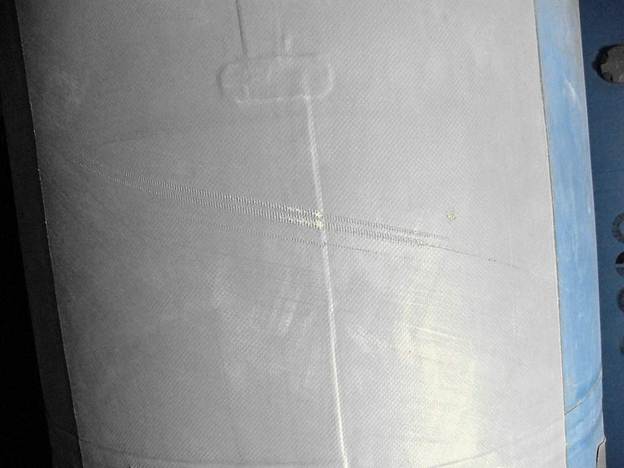
This damage is from rebar. One can see that the boat actually ran over the top of it, and it left a characteristic pattern. In this case the double bottom did its job. The dragging can be avoided. Rebar is not so easy to spot. Good job Double bottom layer! Someone should be thinking how strong this boat really is, and what the floor is for. I can feel the pain of my boat when I hit things in the river, but because I build boats, I also feel their pain when they are needlessly damaged by draging them.
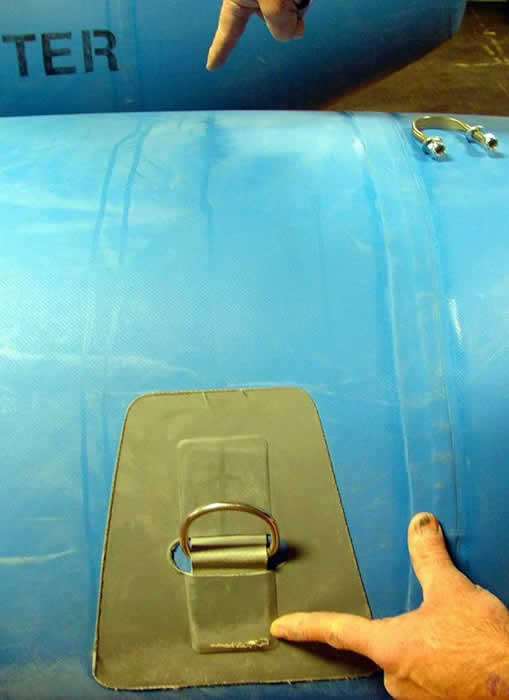
This is damage that is caused by a boat rubbing up against a rock in an eddy. It is a good thing that it wore the top of a D ring. What if that were wear on the inflatable tube? Did the boatman dodge a bullet? You bet!

This damage may be associated with that rock damage because the rocking action of the boat hitting the rock and the combination of a loose frame rubbing across the inflated tube. We cannot be sure. It could be rope damage too from a drink sack.
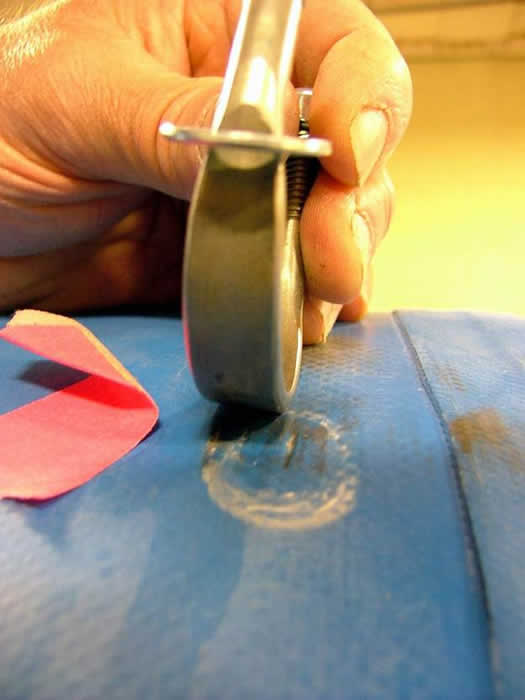
This damage was caused by the U bolt on the frame on the inside. It happened to be diagonal with the rock damage above, and on the inside of the boat frame. There could be a strong correlation between these two problems. However this is the only place on the entire two tubes where a u bolt wore through the coating. Where the other U bolts are located there are no marks at all. Could it be caused by a loose U bolt, or a deflated tube or repeatedly bouncing off of rocks? Who knows, but it was caused by something that did not exist on 20 other locations. This makes this damage mighty suspicious.
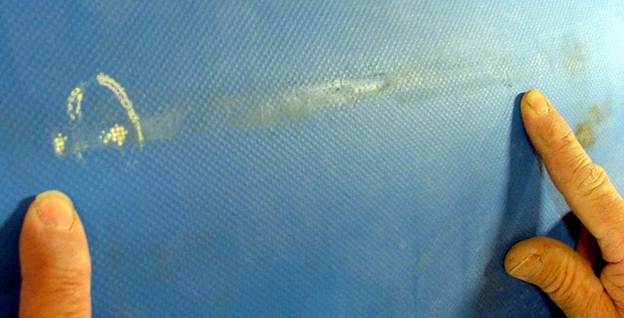
This damage was caused because a rope was tied under the long frame rail, and it worked its way back to a point where it stopped and did a considerable amount of damage to the coating. Ropes do not have enough surface area to be used as frame tie downs. But in this case one can see that the damage happened over length. We think this was caused by a drink sack working its way along the frame. It would be a much better idea to tie the drink sack to a cross member, that does not touch the inflatable, and then throw the drink sack over into the river. That way the weight of all the gear inside the frame is not resting on a single point of rope.
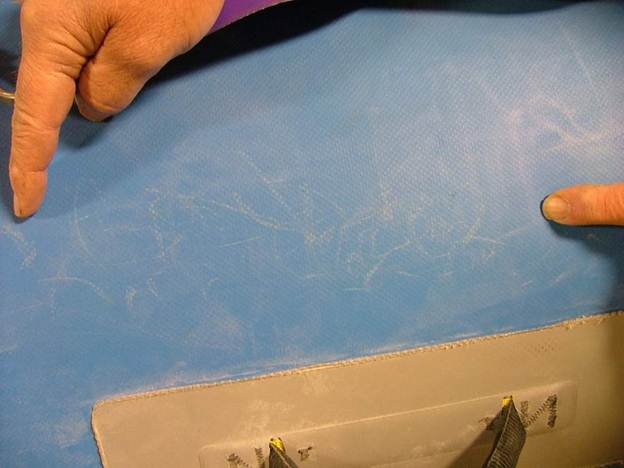
These marks have not gouged out any coating, but they are from either another boats frame, oars, or oar pins. Note the circular design that indicated movement in the eddy against another boat. In this kind of eddy, one should consider tieing all of the boats together, taking the oars off, or using something between rafts that will help keep wear between boats from being an issue.

This damage is caused by objects that have cut through the coating on the fabric. Note that one side is beveled toward the exposed fabric, and the other side has the coating pushed away from the exposed fabric. There is no scratch leading into the damage. So this was not caused in the river. It was caused during transport, when the tubes were rolled up, and the rolled edge was exposed to whatever caused the damage (It could even be a cooler). The fact that they are at the top of the D ring patch is a gives it away. That is an easy place for the tube to fold when deflated. This line would be where the tubes were folded, producing a sharp point of fabric that offers a relatively hard point to wear. On this set of tubes there is other damage just like this along a line going lengthwise down the tubes. There were other marks on the opposite side too. One tube has one side that does not have any of these types of marks. Therefore, one side of one tube escaped damage. That side never had a chance to rub against anything yet. We looked at the boat bag, and there was no damage on the boat bag. So if the ends of the tube were sticking out of the boat bag, they could have gotten damaged. However the boat bags are mostly un harmed, and unscratched. This leads us to believe that they did not travel back home inside of the bag, when this damage happened. If you have to, take your boat bags with you on the trip. But do not use them for garbage or rodents may decide to eat your boat when it is stored in the barn.
When an inflatable folds from deflation, there is a relatively hard point (at the tip of the pen) That can rub on things in the trailer or the back of the truck. It is important to try to keep these points of fold away from anything that can wear on the material. It is a bad idea to suck all the air out of your inflatable. That makes these hard points even more prominent.

These are the boat bags that the tubes came to us in. They look real good. No stains. No abrasions. If the tubes got holes in them when in the bag, then the bags would have holes in them also. There was one small abrasion on one, but it did not go through the bag.

These are my boat bags. I take good care of my Eltigre, and there are no cut holes in these bags either. These are 6 years old, and they have lots of frame stains where we have laid them into or on top of the frames on the way to the put in.
When this boat came back in for repair I could feel it asking me to write this web page. "Please let your customers know that we like the river too, and we know we have to face the dirt road, but if they know how hard it is on us, we will get better care, and get to be out on the water more, instead being in the repair shop."
Cold Crack- Fold Cracking- and Fabric Checking
We do have some good cold weather testing. Two different sets of tubes were used as a sled to go 600 miles on a traverse to the South Pole Called the Pig Traverse. One set was PVC polyester 35 oz. material, and the other was 33 oz. urethane Nylon material. One set of Urethane Polyester tubes were used to do the traverse from Thule Greenland to the summit 1500 miles south east. These are extreme conditions, and we will be happy to share our information with you if you need to make a choice between fabrics. Suffice it to say that the best cold crack specs and tests came with a urethane/nylon material 33 oz.
The only time we developed cracks that leaked were when cat tubes were rolled tightly, and in the same way each time. This only happened once.
If you fold your boat, the fold lines will not be in exactly the same place. We do experience an effect in cold weather where the coating may crack. But the manufacturer says -30, and I think with butt seams it may be -20. It is important that you warm up tubes somewhere before inflating them when at those cold of temps. If you get trapped on a river that is icing up, (this has happened to a customer, but he did not complain of cracks in the raft) and you find yourself deflating a boat in sub 0 temps, please use as little force as necessary on the folds. Then try to get your boat warmed up to do the storage roll for the rest of the winter. I only know of one time when this scenario happened, on a fishing trip in BC Canada, in November when the temp dropped from above freezing to -30 F in 24 hours. The team had to row like mad to avoid getting trapped.
Check marks are places where the pigment is moved away in the coating resulting in a white line. They will go away when the tubes are inflated and warmed up. They seem to do no harm, and boats 25 years old have had this problem, and are still working. We have on occasion taken a boat with these check marks and reheated the fabric with heat guns, and then rolled up the same boat and sent it back. When we explain to the customer what is going on, we usually do not hear from them again. These are not cracks in the coating that make a leak.
If there is a crack in the coating, making a leak, then we are experiencing something that we have not seen before, unless the boat gets rolled tightly and in the same place over and over again. I prefer to fold a boat, and keep the stress off of the fabric as much as possible. Leaving a little air in the boat would not hurt either. If the boat is completely evacuated with a double action pump or a shop vac, (as we do no shipping) the boat will have more of a tendency to develop checking, or possibly a crack (although we have not seen this).
Rodent Dammage
Do not use your boat bags for garbage. Do not store your boat in a place where there are hungry rodents. If you have to, purchase Decon and keep it by your boat. Rodent dammage is the absolute worst, and it is totally avoidable.
One freight company put a hole in a brand new boat by loading it on top of something sharp, and then putting something heavy on it. It went from Aztec to Durango, then to Cortez. The sharp object went through a cardboard box, through the boat bag, and through the double bottom material on the raft. That was 80 miles of highway in a cargo van, and not a bouncy dirt road. We replaced the boat for the customer. We are waiting to see if we get any insurance money form the freight damage. These things can happen, and we know what the damage looks like. By the way the characteristic damage along that line is the same reason why we started to give customers boat bags. Boat bags have reduced our warranty issues by 90%.
To summarize: Inflatable boats do their hardest work on the back of trucks and on trailers on the way to and from the river, and especially when they are deflated and rolled up. When riding on a raft, you are aware of what is happening to your boat, and can be amazed at what they can handle. When at camp it is easy to think of your boat like a car safely parked in a garage. However this is not always the case. Be aware of the dangers of rising water, and what eddy currents can do to your boat on the rocks, and to other boats. Be aware of what can happen to your boat during transportation to the put in, and what happens before it is in the water. Also be aware of what happens when de rigging at the take out and how the boat is transported back home. This document is all about getting customers to be more aware of good river and transportation choices. We want your boat to last 20 years. Most of the boats we made in 1988 are still with us. So we know it works.
Thank you very much for reading this. We hope this helps.
Sincerely,
Jack Kloepfer
and the Crew of JPWinc
home | products | pictures & information | find a dealer | river stories & testimonials | related info | FAQ | contact us
Order inquiries: shop.jpwinc@gmail.com
Custom & Prototype inquiries: pschoser.jpwinc@gmail.com
© 2011 Jack's Plastic Welding, Inc
Toll Free 1-800-742-1904
P. 505-334-8748, F. 505-334-1901
